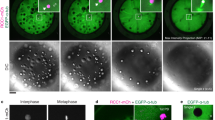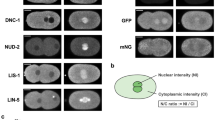Abstract
The assembly of a functional mitotic spindle is crucial for achieving successful mitosis. Aurora A kinase is one of the key regulators of mitotic events, including mitotic entry, centrosome maturation and spindle bipolarity1,2. Caenorhabditis elegans Aurora A (AIR-1) is responsible for the assembly of γ-tubulin-independent microtubules in early embryos3; however, the mechanism by which AIR-1 contributes to microtubule assembly during mitosis has been unclear. Here we show by live-cell imaging and RNA-mediated interference (RNAi)-based modulation of gene activity that AIR-1 has a crucial role in the assembly of chromatin-stimulated microtubules that is independent of the γ-tubulin complex. Surprisingly, the kinase activity of AIR-1 is dispensable for this process. Although the kinase-inactive form of AIR-1 was detected along the microtubules as well as on centrosomes, the kinase-active form of AIR-1 was restricted to centrosomes. Thus, we propose that AIR-1 has a kinase-dependent role at centrosomes and a kinase-independent role for stabilizing spindle microtubules and that coordination of these two roles is crucial for the assembly of mitotic spindles.
This is a preview of subscription content, access via your institution
Access options
Subscribe to this journal
Receive 12 print issues and online access
$209.00 per year
only $17.42 per issue
Buy this article
- Purchase on Springer Link
- Instant access to full article PDF
Prices may be subject to local taxes which are calculated during checkout





Similar content being viewed by others
References
Barr, A. R. & Gergely, F. Aurora-A: the maker and breaker of spindle poles. J. Cell Sci. 120, 2987–2996 (2007).
Carmena, M., Ruchaud, S. & Earnshaw, W. C. Making the Auroras glow: regulation of Aurora A and B kinase function by interacting proteins. Curr. Opin. Cell Biol. 21, 796–805 (2009).
Motegi, F., Velarde, N. V., Piano, F. & Sugimoto, A. Two phases of astral microtubule activity during cytokinesis in C. elegans embryos. Dev. Cell 10, 509–520 (2006).
Hannak, E. et al. The kinetically dominant assembly pathway for centrosomal asters in Caenorhabditis elegans is γ-tubulin dependent. J. Cell. Biol. 157, 591–602 (2002).
Hannak, E., Kirkham, M., Hyman, A. A. & Oegema, K. Aurora-A kinase is required for centrosome maturation in Caenorhabditis elegans. J. Cell Biol. 155, 1109–1116 (2001).
Strome, S. et al. Spindle dynamics and the role of γ-tubulin in early Caenorhabditis elegans embryos. Mol. Biol. Cell. 12, 1751–1764 (2001).
Bobinnec, Y., Fukuda, M. & Nishida, E. Identification and characterization of Caenorhabditis elegans γ-tubulin in dividing cells and differentiated tissues. J. Cell. Sci. 113, 3747–3759 (2000).
Toya, M., Iida, Y. & Sugimoto, A. Imaging of mitotic spindle dynamics in Caenorhabditis elegans embryos. Methods Cell. Biol. 97, 359–372 (2010).
Karsenti, E., Newport, J. & Kirschner, M. Respective roles of centrosomes and chromatin in the conversion of microtubule arrays from interphase to metaphase. J. Cell Biol. 99, 47s–54s (1984).
Heald, R. et al. Self-organization of microtubules into bipolar spindles around artificial chromosomes in Xenopus egg extracts. Nature 382, 420–425 (1996).
Khodjakov, A., Cole, R. W., Oakley, B. R. & Rieder, C. L. Centrosome-independent mitotic spindle formation in vertebrates. Curr. Biol. 10, 59–67 (2000).
Tsai, M. Y. & Zheng, Y. Aurora A kinase-coated beads function as microtubule-organizing centres and enhance RanGTP-induced spindle assembly. Curr. Biol. 15, 2156–2163 (2005).
Koffa, M. D. et al. HURP is part of a Ran-dependent complex involved in spindle formation. Curr. Biol. 16, 743–754 (2006).
Hamill, D. R., Severson, A. F., Carter, J. C. & Bowerman, B. Centrosome maturation and mitotic spindle assembly in C. elegans require SPD-5, a protein with multiple coiled-coil domains. Dev. Cell 3, 673–684 (2002).
Schumacher, J. M., Ashcroft, N., Donovan, P. J. & Golden, A. A highly conserved centrosomal kinase, AIR-1, is required for accurate cell cycle progression and segregation of developmental factors in Caenorhabditis elegans embryos. Development 125, 4391–4402 (1998).
Bischoff, J. R. et al. A homologue of Drosophila aurora kinase is oncogenic and amplified in human colorectal cancers. EMBO J. 17, 3052–3065 (1998).
Littlepage, L. E. et al. Identification of phosphorylated residues that affect the activity of the mitotic kinase Aurora-A. Proc. Natl Acad. Sci. USA 99, 15440–15445 (2002).
Ohashi, S. et al. Phospho-regulation of human protein kinase Aurora-A: analysis using anti-phospho-Thr288 monoclonal antibodies. Oncogene 25, 7691–7702 (2006).
Haydon, C. E. et al. Identification of novel phosphorylation sites on Xenopus laevis Aurora A and analysis of phosphopeptide enrichment by immobilized metal-affinity chromatography. Mol. Cell. Proteomics 2, 1055–1067 (2003).
Eyers, P. A. & Maller, J. L. Regulation of Xenopus Aurora A activation by TPX2. J. Biol. Chem. 279, 9008–9015 (2004).
Green, R. A. et al. Expression and imaging of fluorescent proteins in the C. elegans gonad and early embryo. Methods Cell Biol. 85, 179–218 (2008).
Gruss, O. J. & Vernos, I. The mechanism of spindle assembly: functions of Ran and its target TPX2. J. Cell Biol. 166, 949–955 (2004).
Ozlü, N. et al. An essential function of the C. elegans ortholog of TPX2 is to localize activated aurora A kinase to mitotic spindles. Dev. Cell 9, 237–248 (2005).
O’Toole, E. T. et al. Morphologically distinct microtubule ends in the mitotic centrosome of Caenorhabditis elegans. J. Cell Biol. 163, 451–456 (2003).
Boudeau, J., Miranda-Saavedra, D., Barton, G. J. & Alessi, D. R. Emerging roles of pseudokinases. Trends Cell Biol. 16, 443–452 (2006).
Abeliovich, H., Zhang, C., Dunn, W. A. Jr, Shokat, K. M. & Klionsky, D. J. Chemical genetic analysis of Apg1 reveals a non-kinase role in the induction of autophagy. Mol. Biol. Cell 14, 477–490 (2003).
Praitis, V., Casey, E., Collar, D. & Austin, J. Creation of low-copy integrated transgenic lines in Caenorhabditis elegans. Genetics 157, 1217–1226 (2001).
Maeda, I., Kohara, Y., Yamamoto, M. & Sugimoto, A. Large-scale analysis of gene function in Caenorhabditis elegans by high-throughput RNAi. Curr. Biol. 11, 171–176 (2001).
Hirota, T. et al. Aurora-A and an interacting activator, the LIM protein Ajuba, are required for mitotic commitment in human cells. Cell 114, 585–598 (2003).
Acknowledgements
We thank F. Motegi, M. Sato and R. E. Carazo-Salas for discussion and critically reading the manuscript. We also thank Y. Kohara, A. A. Hyman, A. Audya and K. Oegema for reagents and T. Toda and M. Mishima for helpful comments. We are grateful to the Sugimoto Laboratory members for their support. This work was supported by MEXT KAKENHI 17017038 and JSPS KAKENHI 19671003 to A.S. and by JSPS KAKENHI 21570209 to M. Toya. M. Toya is a RIKEN Special Postdoctoral Researcher. Some nematode strains used in this work were provided by the Caenorhabditis Genetics Center, which is funded by the National Institutes of Health National Center for Research Resources.
Author information
Authors and Affiliations
Contributions
M. Toya and A.S. designed the research; M. Toya carried out RNAi, imaging analyses and phenotype characterization; M. Terasawa carried out AIR-1 protein production and kinase assays; K.N. contributed to plasmid construction and biochemical experiments; Y.I. contributed to RNAi experiments and construction of transgenic lines; M. Toya and A.S. wrote the paper; A.S. supervised the study and finalized the manuscript.
Corresponding author
Ethics declarations
Competing interests
The authors declare no competing financial interests.
Supplementary information
Supplementary Information
Supplementary Information (PDF 2068 kb)
Supplementary Information
Supplementary Table 1 (XLS 15 kb)
Supplementary Information
Supplementary Movie 1 (MOV 3169 kb)
Supplementary Information
Supplementary Movie 2 (MOV 2241 kb)
Supplementary Information
Supplementary Movie 3 (MOV 2528 kb)
Supplementary Information
Supplementary Movie 4 (MOV 2136 kb)
Supplementary Information
Supplementary Movie 5 (MOV 3653 kb)
Supplementary Information
Supplementary Movie 6 (MOV 3252 kb)
Supplementary Information
Supplementary Movie 7 (MOV 3489 kb)
Rights and permissions
About this article
Cite this article
Toya, M., Terasawa, M., Nagata, K. et al. A kinase-independent role for Aurora A in the assembly of mitotic spindle microtubules in Caenorhabditis elegans embryos. Nat Cell Biol 13, 708–714 (2011). https://doi.org/10.1038/ncb2242
Received:
Accepted:
Published:
Issue Date:
DOI: https://doi.org/10.1038/ncb2242
This article is cited by
-
Nuclear Aurora kinase A switches m6A reader YTHDC1 to enhance an oncogenic RNA splicing of tumor suppressor RBM4
Signal Transduction and Targeted Therapy (2022)
-
PROTAC-mediated degradation reveals a non-catalytic function of AURORA-A kinase
Nature Chemical Biology (2020)
-
Insights into the non-mitotic functions of Aurora kinase A: more than just cell division
Cellular and Molecular Life Sciences (2020)
-
Biology and genome of a newly discovered sibling species of Caenorhabditis elegans
Nature Communications (2018)
-
A water-mediated allosteric network governs activation of Aurora kinase A
Nature Chemical Biology (2017)



